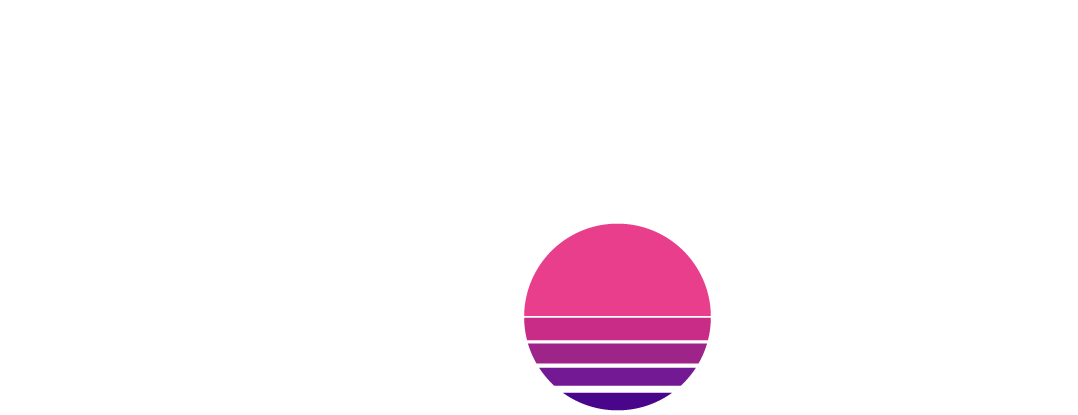How often do we take a look at the design of a Magic set? Too often we dwell on the development of the set. We discuss the power levels of cards in a variety of formats. We make predictions about what will see play in tournaments. We make lists of draft picks and archetypes. But when do we step back, look at the set as a whole, and try to glean the intent of the design team and evaluation their execution?
Khans vs. Dragons
Fate Reforged is a unique set. The design of Tarkir as a block called for a middle set which could be drafted with both the first and final set. All three sets would never be drafted together. Because of this, Fate Reforged was the linchpin holding the block together. That means the design of the set needed to bridge the two book-end sets: Khans of Tarkir and Dragons of Tarkir.
The Khans vs. Dragons theme ultimately became the core idea for the design of Fate Reforged. In Khans of Tarkir the design revolved around the conflict of Magic’s five wedge combinations with each other. In Fate Reforged, the design is no longer interested in wedge combinations but more interested in the conflict between the Khans and the Dragons.
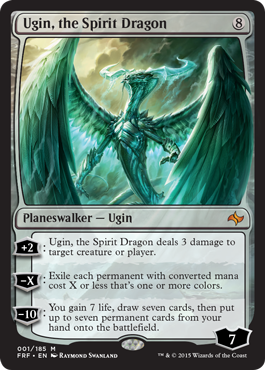
The Five Clans and Their Khans
The same five clans that we were introduced to in Khans of Tarkir still exist in Fate Reforged, at least by name. Their theme is still similar, but the design of each clan has changed somewhat. This is because Fate Reforged is no longer concerned about designing around the wedge-color combinations. Fate Reforged is concerned about designing around the conflict between clans and dragons.
This change is most apparent in the colors that each clan is represented in. Abzan was the combination of white, black, and green in Khans of Tarkir. In Fate Reforged, there are eight white and eight green cards with an Abzan watermark, but only one black card. Jeskai was white, blue, and red in KTK, but in FRF there are seven white, seven blue, but only three red Jeskai cards.
The same holds true for the Mardu (one white, six black, six red), Temur (one blue, five red, ten green), and Sultai (six blue, eleven black, one green). Each clan is still, technically, in its three-color wedge, but the dominant colors of each clan are designed for the allied-color pair in each wedge.
Abzan is now a green/white clan with a hint of black. Jeskai is now a white/blue clan with a hint of red. Sultai is now a blue/black clan with a hint of green. Mardu is now a black/red clan with a hint of white. Temur is now a red/green clan with a hint of blue. Why the change?
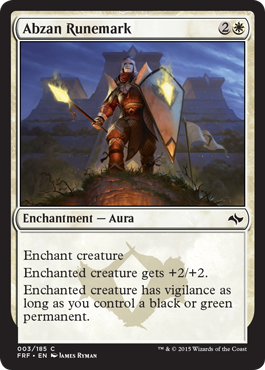
The Five Broods and Their Leaders
In addition to the five clans of Tarkir we’ve been introduced to the five dragon broods. These broods have their own watermarks which appear on the 11 dragon cards in the set. These dragons come in two varieties. Six of them, the commons and uncommons, are mono-colored. Five of them, the legendary rare dragons, represent the leaders of the broods and each allied-color pair.
The five broods are each denoted by a watermark and contain the following dragons:
- Dromoka, the Eternal (green/white) & [casthaven]Wardscale Dragon [/casthaven](white)
- Ojutai, Soul of Winter (white/blue) & [casthaven]Mindscour Dragon[/casthaven] (blue)
- Silumgar, the Drifting Death (blue/black) & [casthaven]Noxious Dragon[/casthaven] (black)
- Kolaghan, the Storm’s Fury (black/red), [casthaven]Lightning Shrieker[/casthaven] (red), & [casthaven]Shockmaw Dragon[/casthaven] (red)
- Atarka, the World Render (red/green) & [casthaven]Destructor Dragon[/casthaven] (green)
Each brood is aligned to an allied-color pair. If you’ve been paying attention, you’ll recall that each clan is also now aligned to an allied-color pair. This is where the design of Fate Reforged really starts to take shape.

A Conflict Among Allied Colors
Each of the five clans is in direct conflict with one of the dragon broods. In each case it is the dragon brood which matches the colors of the clan. What’s more important is that the philosophies on both sides of the conflict are very similar. These clans, in the future that becomes Khans of Tarkir, revere the most prominent quality of the dragon brood that they fought in the past.
A large amount of the cards designed for Fate Reforged focus on this conflict. We so often see designs where the enemy colors conflict with each other, but how often do we see design based around the question: how does green/white battle green/white? This was the challenge of the design team.
The answer can be found two places. The first is the mechanics of each clan and the mechanics of each dragon compared side-by-side. The second is in the modal cards which appear in three separate cycles.
Clan Mechanics vs. Brood Mechanics
The Abzan as a clan believe in strength in numbers and value the durability of their soldiers. This plays out nicely in the Bolster mechanic which fortifies the weakest link in your army. This is highlighted by [casthaven]Daghatar the Adamant[/casthaven], the Khan of the Abzan, who can move the counters between creatures. It turns out that Dromoka also uses the Bolster mechanic, obviously the inspiration for the Abzan to do so as well.
The Mardu also have a new mechanic in Fate Reforged called Dash, which is a kind of super-haste. Kolaghan, the Storm’s Fury, which is the black/red dragon, has the exact same mechanic.
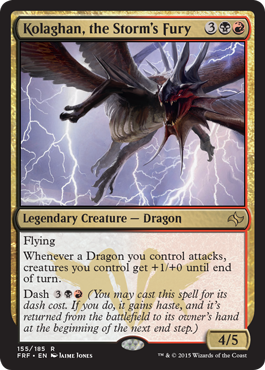
An interesting note is that the Jeskai, Sultai, and Temur mechanics (prowess, delve, and ferocious) don’t show up on the dragons they revere. We already know that in Dragons of Tarkir the Abzan and Mardu mechanics will be bolster and dash, but the Jeskai, Sultai, and Temur mechanics will not be prowess, delve, and ferocious. Perhaps the mechanics of Ojutai (tapping permanents), Silumgar (give creatures -1/-1), and Atarka (double-strike) will be part of those clans in Dragons of Tarkir. But, perhaps I’m getting ahead of myself.
Regardless, the design of the clans as allied pairs and the dragons as allied pairs is no coincidence. What’s interesting is that the enemy color pairs are hinted at in Fate Reforged but not given any real substantial presence. There is a loose cycle of five instants which are each enemy colors. Each one could theoretically fit in either clan that the enemy pair existed in for Khans of Tarkir. Perhaps this is a glimpse of the future that came to be in KTK. Without the heavy ally-colored influence of the dragon broods, the clans explored the nature of enemy-colored philosophies.
I would be remiss if I didn’t point out the relationship between the reprinting of the ally-colored fetchlands in Khans of Tarkir as dragon graves, and the ally-colored alignment of the five legendary dragons of Fate Reforged. As the clans are now ally-colored as well, and could remain as much in Dragons of Tarkir, it is becoming clearer now how the ally-colored fetchland cycle fits in from a design perspective.
Mark Rosewater has commented that the five fetches were the first five cards in KTK because development needed them. However, it’s very elegant to see how the design team was able to make them meaningful and fit the overall design of the block. They don’t feel out of place or forced in, which easily could have happened.
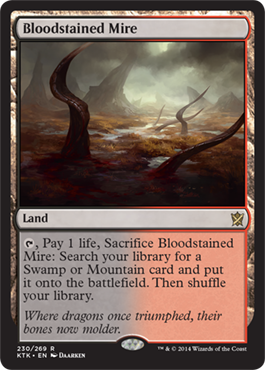
Modal Cycles
The theme of Khans vs. Dragons plays out nicely in the three cycles of modal cards. These are cards with two choices that the players need to pick from. There is a lot of flavor built into the design of these cards which is interesting because it implies a sense of top-down design. However, it is more likely that the design was bottom-up with the intent of making cycles of modal cards, and the flavor of choosing between Khans and Dragons came later.
The first cycle is at common and feature five creatures. The first is [casthaven]Sandsteppe Outcast[/casthaven], a white creature which gives you the option of getting a 3/2 creature or a 2/1 creature and a 1/1 flying spirit. The next is [casthaven]Aven Surveyor[/casthaven], a blue creature with flying that gives you the option of getting a 3/3 creature or a 2/2 and bouncing another creature. The black member of the cycle has been talked about a lot and is [casthaven]Hooded Assassin[/casthaven]. The choice here is between a 2/3 creature or a 1/2 creature and destroying another creature that took damage that turn. [casthaven]Defiant Ogre[/casthaven] is the red member of the cycle and provides for a 4/6 creature or a 3/5 and destroying an artifact. Last, but not least, is [casthaven]Ainok Guide[/casthaven], which for 1G can either be a 2/2 creature or a 1/1 which tutors up a basic land and puts it on top of your deck.
Each of these represents an interesting choice. A bigger creature for your army or a smaller creature with a very useful effect. A cycle of five means that every common has about a 5% chance of being modal. So you’ll see one of these in every other pack, more or less.
The second cycle is a loose cycle of modal spells. I say it is loose because they appear at different rarities across colors. Also some are instants and some are sorceries. The white spell is [casthaven]Valorous Stance[/casthaven], an instant which gives the choice between giving a creature indestructible until end of turn, or destroying a creature with four or more toughness. Here we begin to see the conflict between dragons and non-dragons. Do you destroy a monster or do you protect your own army? Side-note, killing monstrous dragons plays nicely with killing Theros’s monstrous creatures.
Each card in the cycle feels like two sides of the same coin. The blue spell, an uncommon called [casthaven]Fascination[/casthaven], lets you have each player draw cards or put the cards from their library into their graveyard. Green has an uncommon combat trick, [casthaven]Ruthless Instincts[/casthaven], that either pumps a creature that is attacking or untaps and enhances a creature that is not attacking. The red spell is a rare called [casthaven]Mob Rule[/casthaven] which lets you gain control either all creatures with power 4 or greater or power 3 or less. I left the black spell for last. It’s called [casthaven]Crux of Fate[/casthaven] and looks like this:
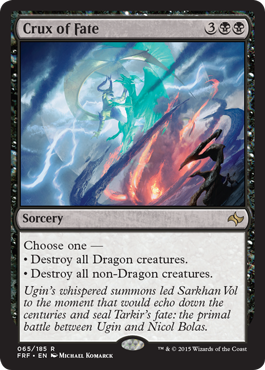
That’s some very tight storytelling in the form of the design of a card. While the idea of the modal cycles is very bottom-up in design, the flavor of this spell’s modes is 100% top-down for Fate Reforged.
The final modal cycle is a collection of five rare enchantments called the sieges. Each of these features a choice, literally, between Khans or Dragons and creates a permanent effect based on the choice. Each choice is flavored for the conflict taking place at that siege.
[casthaven]Citadel Siege[/casthaven] features the Abzan vs. [casthaven]Wardscale Dragon[/casthaven] and gives you the choice between putting +1/+1 counters on your creatures or tapping down an opponent’s creature each turn. [casthaven]Monastery Siege[/casthaven] features the Jeskai vs. [casthaven]Mindscour Dragon[/casthaven] and lets you pick between looting every turn on your draw step or making your opponent’s spells that target you and your permanents cost more mana. The rest of the cycle plays out similarly, featuring an effect that defends the clan (Khans) or an effect that can attack the clan (Dragons).
Manifest
The conflict between the Khans and the Dragons is the core theme of the design of Fate Reforged. It plays out on 107 cards in a set with 185 cards. That’s 57.8% of the set! So what’s the other 42.2% up to? Time travel.
The second theme of Tarkir as a block is time travel. We begin in the present world of Tarkir where there are no dragons. [casthaven]Sarkhan Vol[/casthaven] travels back in time to the past where there are dragons. He will (obviously) do something to change the timeline so that when we return to the present there are still dragons.
While the flavor of the set tells this story well, and that is the job of the creative team, the design of the set also aims to tell this story through the mechanics of the set. We’ve seen that each clan will have alternate-timeline mechanics. Khans of Tarkir showed us one timeline and Dragons of Tarkir will show us another. The clans in the past have one of those two mechanics.
But, design had one more trick up their sleeve: a mechanic that instead of just having alternate timeline versions would also have a prototype version that (perhaps only) existed in the past. That mechanic is Manifest and it is the proto-version of Morph.
Manifest appears on only 17 of the remaining 78 cards in the set. It accounts for roughly 9.2% of the entire set. The design of manifest is to show a version of morph that is fueled by the power of the dragons. Morph, fueled by the magic of the surviving clans, was a shadow of what manifest once was. It will be very interesting to see what this mechanic looks like in Dragons of Tarkir. There isn’t a ton of design space for face-down creatures, but there’s certainly enough for another face-down creature mechanic to show up in DTK.
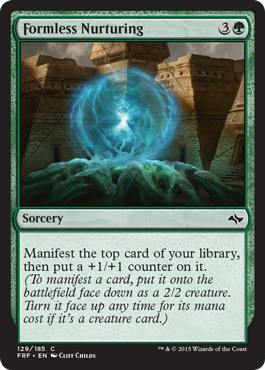
Everything Else
A total of 67% of the set, or two-thirds, is devoted to the design of the conflict between ally-colored clans and ally-colored dragon broods and the design of the time-traveling morph mechanic. So what’s left for the remaining 61 cards? Well we can scratch off 10 basic lands and we have 51 cards that are all over the place. The most interesting is the planeswalker Ugin and among the least interesting are some vanilla common creatures spread out across the colors.
For a set meant to be drafted alongside two independent sets, there is not a lot of utility in Fate Reforged. I get the impression that the bulk of the core limited staple effects, such as removal and burn, appeared in Khans of Tarkir and will appear in alternate form in Dragons of Tarkir. Since only one pack of Fate Reforged will come with two packs of the larger sets, it doesn’t make sense to design the utility spells into the middle set.
This left the designers some interesting space to play with to help facilitate the conflicts of Tarkir’s clans and broods. Many of the remaining cards are combat focused including tricks like [casthaven]Sandblast[/casthaven] and [casthaven]Refocus[/casthaven]. Some of them are other cool ways to design time travel into the game mechanically, like [casthaven]Renowned Weaponsmith[/casthaven].
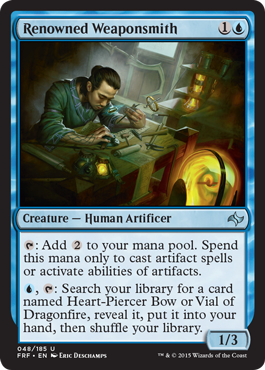
Conclusions
There appear to have been two core design goals for Fate Reforged
- Design cards around the conflicts of ally-colored clans and broods
- Design cards mechanically related to time travel
It should be obvious why the conflict cards take up well over half the set while time travel only accounts for about 10%. Magic is a game about conflict. Still, it is very interesting to see some of the time travel designs and how elegant they capture the idea of a mutable point in time and the two alternate timelines that stem from it.
Khans of Tarkir and Fate Reforged seem to form a very interesting puzzle. Pieces of the flavor and the mechanics begin to fall together in obvious patterns. Sometimes these might be too obvious, but there is still a valuable “aha” moment when you recognize something designed in KTK and how it links to something designed in FRF.
Of course, the final payoff will come when we complete the puzzle in a few months with Dragon’s of Tarkir. But, for now at least, I’m content to see how Fate Reforged unfolds.
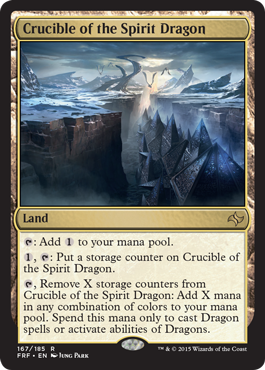
The Quick Hits
- Frank Lepore shares the tale of his journey to the pacific northwest with Melissa DeTora and friend Mike on their way to their new lives in Seattle [TCGPlayer]
- Danny Brown wants to see customized cube drafting on MTGO which assumes that anything happy can happen on MTGO [Quiet Speculation]
- Owen Turtenwald walks through four mistakes he made at GP Denver in great detail [Channel Fireball]
- A.E. Marling brings you an alternative review of Fate Reforged covering the flavor of the set [Gathering Magic]
- Paulo Vitor Damo da Rosa talks about the life of a professional Magic player [Channel Fireball]
- Mike Linnemann reviews the art of Fate Reforged and asks the all-important question of whether or not the art for Pyrotechnics features a gun [Gathering Magic]
- Jason Alt has the latest news on the saga of buylist company White Lion [Quiet Speculation]
- Matt Sperling is on a quest to achieve Platinum Pro status and he’s blogging about the journey [Sperling Grove]
- Last but not least, April King moderated a panel of Magic artists at Grand Prix Omaha and has the audio and transcription for us [Gathering Magic]
Wallpaper of the Week

Shu Yun, the Silent Tempest is the Khan of the Jeskai in the time of Fate Reforged. You can see that he has the same mark on his head as Narset, the Khan of the Jeskai in the time of Khans of Tarkir. The ghostfire scar on his exposed shoulder is a nice touch as well. The coloring is very blue which I suspect is appropriate given that the Jeskai are centered in blue on the color pie. I would have liked a little more color overall, but it’s not too bad. Shu Yun is off-centered which is good for a desktop.
Grade: B+
What We Learned is a weekly feature here at Hipsters of the Coast written by former amateur Magic Player Rich Stein, who came really close to making day two of a Grand Prix on several occasions. Each week we will take a look at the past seven days of major events, big news items, and community happenings so that you can keep up-to-date on all the latest and greatest Magic: the Gathering community news.

